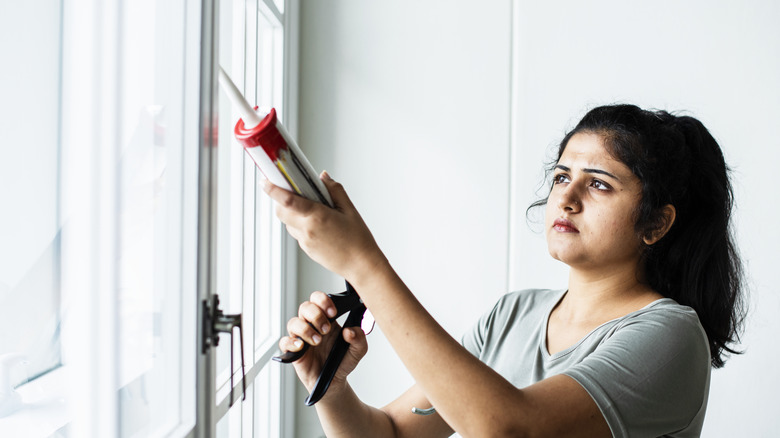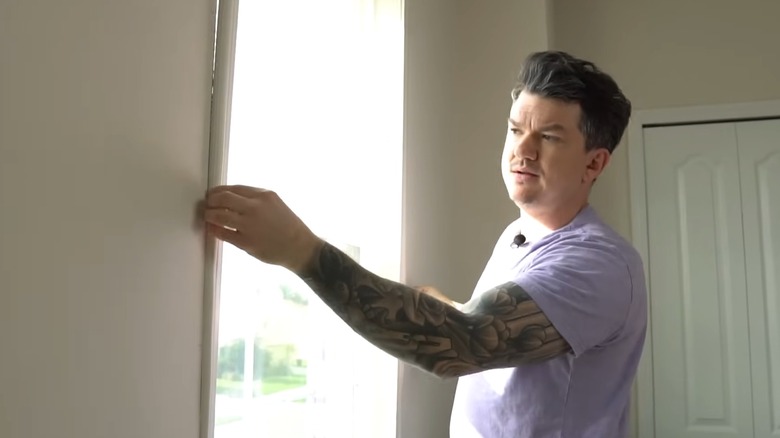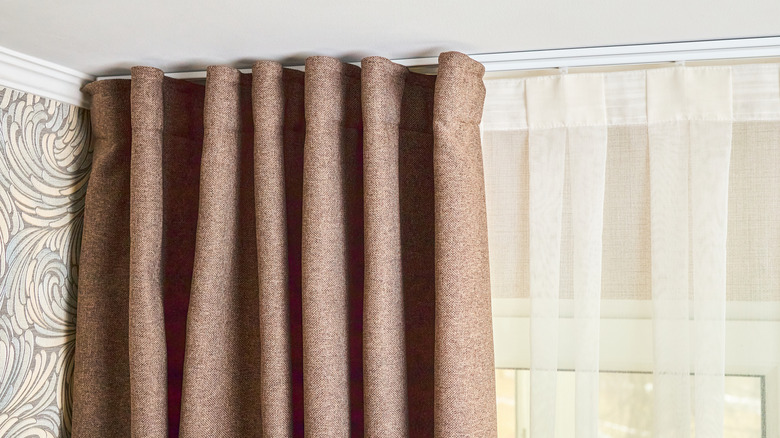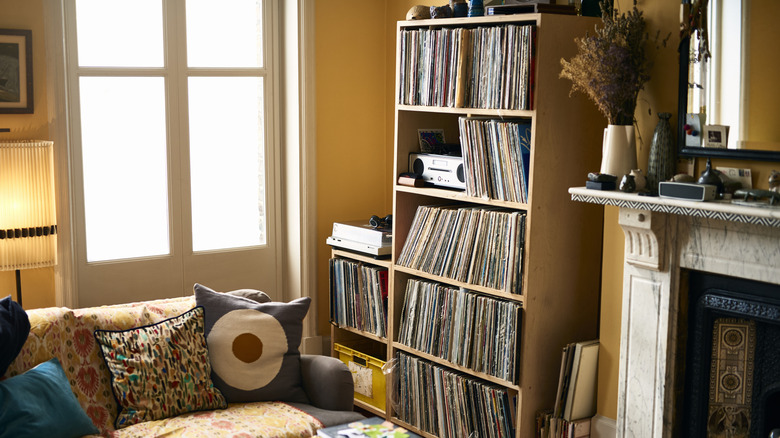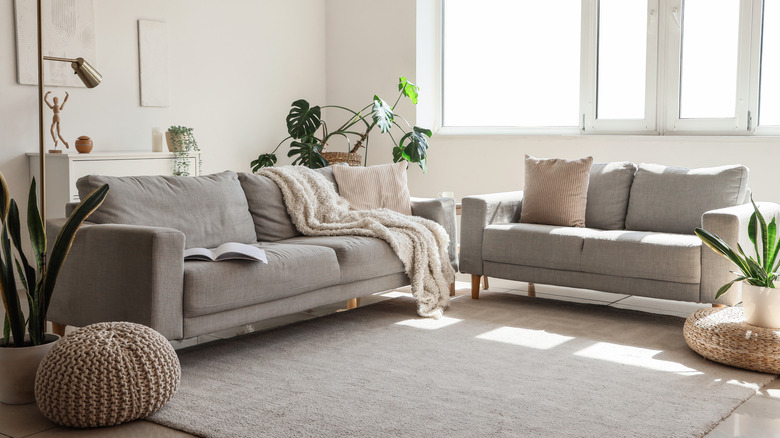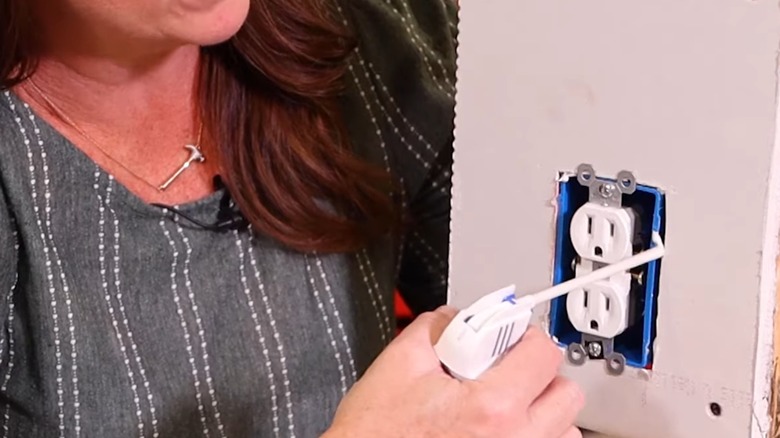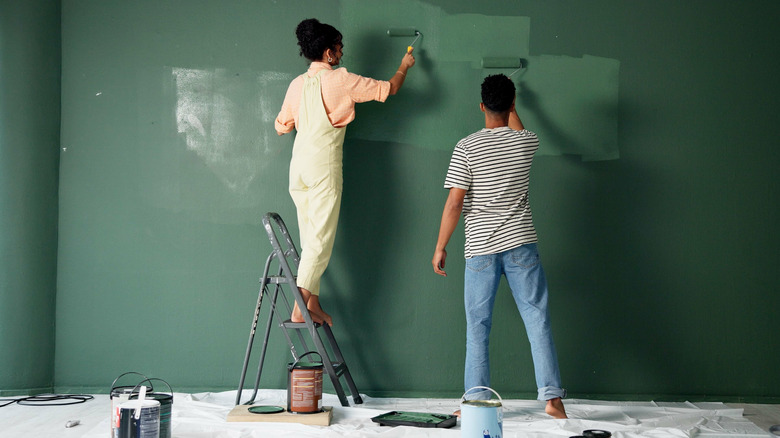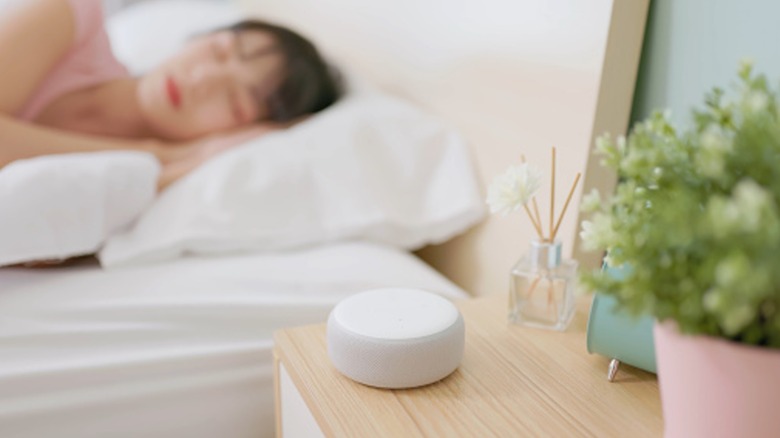Top Tips For Soundproofing Your Apartment The Renter-Friendly Way
We may receive a commission on purchases made from links.
Renting an apartment has its perks. You don't have to wonder why your toilet won't stop leaking, as you can simply request the management to fix it. Nor do you have to wake early to shovel snow from the driveway since such upkeep doesn't fall under your purview. The ready availability of a large community is another lovely addition. But when a mild squabble snowballs and turns your neighbors into petty rebels who constantly slam doors, walk with lead feet past midnight, or play drum solos at 3 a.m., you know something must give. After all, you can only take so much of a hit on your sleep and productivity. When sharing cookies and reconciliatory discussions don't resolve the problem, soundproofing your apartment may be the only recourse. Fortunately, you can undertake several renter-friendly measures, such as using weatherstripping to seal gaps, installing window inserts, and adding bookshelves.
However, before taking action, ensure the landlord is upholding any "right to quiet enjoyment" provisions listed in state laws and local ordinances. These typically limit noise levels and stipulate certain soundproofing requirements. Lease rentals also offer quiet hours (usually 10 p.m. to 8 a.m.) that apartment dwellers must uphold or risk eviction. But, if loud noises persist, scope out your rental for the source, like doors, windows, vents, ceilings, floors, or shared walls, and then selectively apply the soundproofing tips listed below. That being said, note that they'll muffle the sounds to a limited extent, as complete soundproofing requires structural changes.
Seal door and window gaps to reduce the neighborly noises
One cardinal rule worth remembering is that anything that allows drafts also lets noise inside. That's why sealing gaps, cracks, or crevices around your doors and windows is generally the first step to dampen noise migration. To keep it renter-friendly, opt for weatherstripping, as it's affordable and can be removed easily before you move out (you'll just need to fill any screw holes left behind). Applying silicone caulking or acoustic sealant to gaps is another option, but you should check with your landlord before going this route. Alternatively, you can opt for rope caulking (like this Frost King B2 Mortite Fingertip Caulking Cord) which is effective and removable.
For weatherstripping, there are some considerations around cost, durability, and traffic tolerance. For instance, while felt foams are quite cheap, they aren't as durable as some other options. This makes them impractical in busy areas, but a decent choice for rarely used windows. In contrast, metal and vinyl weatherstripping last longer and offer better sound blockage while still being wallet-friendly.
To further solidify your door's soundproofing, consider installing door sweeps, with thick rubber seals, on your in-swinging door's base. As they're flexible, they will fit on most uneven door sills as well. However, because door sweeps tend to drag, they can collect nicks and gouges from repetitive use. For this reason, it's ideal to invest in one that's industrial-grade (such as the M-D Building Products All-Season Door Sweep) made from sturdier, thicker rubber, because the higher durability ensures frequent replacements won't be necessary. You can also opt for automatic door sweeps, like this Pemko Aluminum Automatic Door Bottom. They're relatively friction-free, as the rubber gasket retracts when the door is open, but they can get annoying with the click-click sound. Looking for something that won't require drilling? Consider draft excluders or fabric-based draft stoppers. They simply slide under the door, improving sound insulation.
Install window inserts to block out traffic sounds
If you're sick of waking up to your neighbor's monster truck idling and then burning out at 6 a.m., right outside your bedroom window, maybe it's time to shop for window inserts. Typically made of acrylic (sometimes laminated glass), window inserts are clear panes that snap right over existing window panes inside your room. When in place, they create a sound-deadening air pocket, blocking a plethora of outside noises. However, soundproofing improves in tandem with the air pocket's thickness. So, if you've got shallow panes, window inserts might be unsuitable for your circumstances.
Window inserts are a neat choice when you're unwilling to compromise on your room's aesthetic. Since they're clear, they blend in with the interior design without blocking natural light. They also yield thermal insulation, thus helping reduce energy costs at home. However, their installation requirements and performance vary across manufacturers. On single-glazed windows, customized panes from the brand Indo can cut down the outdoor noise by up to 70% and halve the din for double-pane windows. These specific window inserts stay in place thanks to strips of compression tubing along their edges, making them entirely renter-friendly (no screws required). In contrast, manufacturers like Acoustical Surfaces or Magnetite Canada use magnetic strips on their window inserts. This can allow bigger air spaces but will require drilling. Although window inserts can get expensive, they can be removed and taken along wherever you relocate, however, you will need to fill any holes left behind. You can also find solutions where the magnetic strips attach with an adhesive backing, but the level of renter-friendliness will depend very much on the product and how easy it is to remove the adhesive.
Hang heavy drapes or blankets over windows, doors, or shared walls to muffle high-frequency noise
If you live around an intersection with lots of ongoing traffic or overlook an area where people often gather, consider swapping out your window treatments for thicker drapes. "Insulated," "heavy-duty," or "blackout" curtains generally do the trick, though if you can afford it, you can also opt for soundproof curtains. One of the reasons why soundproof curtains are worth the price is they usually feature multiple layers of fabric. Fabrics absorb sound and convert it into heat energy that dissipates into the room. So, when you put up thick, multi-layered, or tightly woven curtains (or blankets), they absorb and deaden high-frequency sounds (though they are no match for booming lower registers).
Look for drapes with pleats (more folds offer more surface area for sound absorption) in thicker suede or velvet materials. Consider size, too. Insulated curtains must extend at least 6 inches outside the window frame on all sides to prevent sound leakage. Avoid putting the curtains in pairs, as the sound can leak through the mid-split — choose a single piece instead. Besides beefing up your window treatments, consider suspending thick curtains across your entryway door. And if you're worried this will look weird, adding curtains to doorways is actually a trending interior design move at the moment.
Alternatively, you can also hook, staple, or tack wool or fiberglass-based soundproofing blankets to the back of the door; you can do the same on shared walls and ceilings if you don't mind the look. If you do, add a cute tapestry or wall hanging over the top, or, even better (as it will add extra insulation) hang a rug on the wall to act as artwork and a disguise for the soundproofing blanket. Finally, take your soundproofing one step further by employing a Velcro trick. Simply sew Velcro tape onto the curtains or blankets, and apply the other side of the Velcro tape to the window, door back, or door frame (just be sure to keep the maximum weight capacity of the tape in mind). For windows, you can use this trick to seal up the sides of the curtain and prevent sound from leaking through. For doors, you can use it to secure soundproofing blankets in a way that's removable.
Rearrange the furniture, putting heavier pieces next to noisier walls
One of the most basic ways to soundproof a room is to add mass to an exposed shared wall. The added bulk will block the incoming sound, providing much-needed relief. Besides, putting it into motion is quite inexpensive, as you're simply rearranging your pre-existing heavy furniture. If your noisy room has any sectionals, couches, sofa sets, cabinets, bookcases, or armoires, move them against the shared walls. Obviously, your bed and workstation are exceptions to this rule, as they're better off located far from the source of the ruckus.
To further improve the soundproofing, cover the entire wall with heavy elements. For example, if you're moving a big bookcase, try to fit it in a place where it takes up most of the wall, otherwise, the sound will leak through the bare spots. Also, thickly decorate the shelves of your bookcase with books (naturally!), storage baskets, knick-knacks, or other pieces for more bulk. If that proves inadequate, you can further envelop the bookcase with a heavy drape or blanket — it might not look pretty, but it'll keep most grating sounds at bay. Or — where budget allows — fix mass-loaded vinyl rolls (like this SoundproofingMLV Noise Grabber 1 LB Mass Loaded Vinyl) between the wall and the bookcase to muffle noise.
Lay down area rugs or runners to dim the din
While you can't be faulted for focusing entirely on the neighborly melee when soundproofing your apartment, there are just as many instances when you're losing your wits over the noise made within your four walls. Case in point: Your pup and your preschooler are chasing each other around while you're trying hard to draft an unaggressive, professional response to your boss's scathing email. Unless you're living in NYC or LA, where landlords often demand at least 80% of hard flooring be covered by rugs, your hardwood or tile flooring is likely worsening the problem. That's because it reflects the sound as opposed to absorbing it.
In such cases, consider laying down a thick area rug, preferably with a pile height of at least 10 millimeters (around a third of an inch), in high-traffic areas. Avoid thin or loosely woven area rugs, as they don't do as good a job of sound absorption. You can also line your hallways with runners to soften the thumping noise of family members traveling from room to room. Your fellow apartment dwellers will thank you, especially those below. Wondering whether carpeting your floors will help stifle outdoor noise? Honestly, the effects are minimal at best. But, you can help reduce inbound echoes by underlaying the carpet with rug pads, as they're great at stemming sound transmission.
Insulate the gaps in your walls' electrical outlets
This might come as a surprise, but your rental's electrical outlets, light switches, and vents can also serve as pathways to sound transmission. Over time, but especially in old apartments, these outlets develop gaps and cracks in their insulation (assuming they were insulated at all). Sound can easily escape through these openings — but there is a simple fix to seal the gaps.
First, flip the main breaker to the "off" position and pop out the plates of the electrical and light switches. If you notice any gap between the outlet and the wall, caulk it with a silicone or acoustic sealant (Clear Electronic Grade Silicone is one option). Make sure to wipe down any excess, or it might interfere with the system, and replace the plates. This should help keep down the noise to some extent. Also, seal any gaps in the room's baseboards. If the other side of the outlet wall is unfinished, and you have access to it, cover the electrical box (save for the wires) with fire-safe putty pads (like Rectorseal 66345 Metacaulk Firestop Putty). This will further ramp up sound isolation. If your vents seem to be the source of the whooshing sounds you keep hearing, you may have to call in your landlord to get some duct silencing foam installed.
Add a coat of soundproof paint to your walls to dampen mid-frequency sounds
Are you tired of hearing your neighbors going back and forth about their political leanings? Or, perhaps, you've had one too many nights where their TV's murmur kept you awake? Either way, take this as your cue to coat your walls with soundproof paint. What sets soundproof paint apart from its regular counterparts is that it's composed of thermacels. At their core, thermacels hold pockets of color pigment that absorb the incoming or outgoing mid-frequency, aka conversation-level, noise. They also improve the room's acoustics by keeping voice echo in check.
Typically, soundproof paint lowers sound transmission by over 2 decibels for every coat, though the performance varies across brands. You must apply three coats at a minimum to hear results. However, do note that it will not keep booming sounds like bass, car honking, barking, or footsteps down. While this isn't adequate by any means, teaming it up with other soundproofing measures like drapes and weatherstripping can yield noticeable results. You may also consider applying textured paint to the ceilings. Many landlords don't mind if a tenant decides to apply a coat of paint at their own cost; this can actually be beneficial to the property owner. But, make sure to check with your landlord first and choose a paint color that matches the existing wall.
Get yourself a white noise machine
When all soundproofing measures fail to offer respite, invest in a white noise machine, like the Dohm Original Sound Machine. Although it may sound counterintuitive, there's a reason this bedroom essential holds the key to a good night's sleep and a peaceful abode. By emitting a blend of diverse audio frequencies that could pass off for TV static, a white noise machine creates a "noise floor." This means that all the jarring outdoor noises must compete with the white noise before they reach your ears. As you can guess, they rarely outdo the ambient noise and are masked away.
For this method to work, placement is key. Place the white noise machine directly between you and the source of noise (ideally, windows and doors) at ear level. Adjust the sound knob to a level that you won't find distracting. But when that's not possible — for instance, at your home office — raise the distance and dial up the volume. If you're unwilling to make additional investments, ask your smart home device, like Google Home, to play ambient sounds. Or, run any inexpensive fan to drown out your neighbor's babble.

